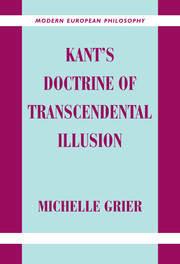Book contents
- Frontmatter
- Contents
- Acknowledgments
- Note on References and Translations
- Introduction
- PART ONE KANT'S DISCOVERY OF METAPHYSICAL ILLUSION
- PART TWO FALLACIES AND ILLUSIONS IN THE CRITIQUE OF PURE REASON
- 3 The Transcendental Employment of the Understanding and the Conflation of Appearances and Things in Themselves
- 4 Transcendental Illusion
- PART THREE THE DIALECTICAL INFERENCES OF PURE REASON
- PART FOUR ILLUSION AND SYSTEMATICITY
- Conclusion
- Selected Bibligraphy
- Index
3 - The Transcendental Employment of the Understanding and the Conflation of Appearances and Things in Themselves
Published online by Cambridge University Press: 30 September 2009
- Frontmatter
- Contents
- Acknowledgments
- Note on References and Translations
- Introduction
- PART ONE KANT'S DISCOVERY OF METAPHYSICAL ILLUSION
- PART TWO FALLACIES AND ILLUSIONS IN THE CRITIQUE OF PURE REASON
- 3 The Transcendental Employment of the Understanding and the Conflation of Appearances and Things in Themselves
- 4 Transcendental Illusion
- PART THREE THE DIALECTICAL INFERENCES OF PURE REASON
- PART FOUR ILLUSION AND SYSTEMATICITY
- Conclusion
- Selected Bibligraphy
- Index
Summary
In the Inaugural Dissertation Kant detailed two different kinds of illusory principles: those which issue from the confusion of sensitive with intellectual conditions of judgment (the “subreptic axioms”), and those which issue solely from the pure intellect (the “principles of harmony”). Kant essentially sustains this distinction in the Critique. The principles of convenience or harmony reappear in modified form in the Appendix to the Transcendental Dialectic in conjunction with Kant's doctrine of transcendental illusion. The confusion of sensible with intellectual conditions of judgments, on the other hand (and the attending conflation of appearances and things in themselves), emerges in connection with a separate theory of judgmental error in the Transcendental Analytic. Kant carefully distinguishes between the “logical” error of judgment and the doctrine of transcendental illusion. Whereas the former is detailed in the Transcendental Analytic, the theory of illusion is presented in the Transcendental Dialectic. In this chapter, I am concerned with the theory of judgmental error in the Analytic.
Even with regard to the latter, however, it seemed that in the Dissertation Kant presented a twofold account of fallacy. In the first place, Kant argued, “sensitive cognitions” are taken with “intellectual cognitions.” The fallacy of subreption, in turn, gives rise to its metaphysical counterpart according to which sensitive objects (phenomena) are confused with intellectual objects (noumena). In this chapter I examine the way in which this “twofold” view of judgmental error is carried over into the Critique of Pure Reason.
- Type
- Chapter
- Information
- Kant's Doctrine of Transcendental Illusion , pp. 69 - 100Publisher: Cambridge University PressPrint publication year: 2001



